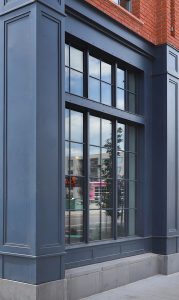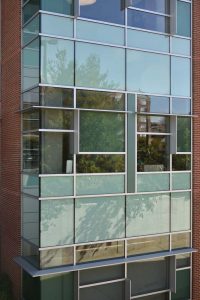Selecting Paint or Anodized Aluminum Finish
08/10/2021
There are many options available for finishing aluminum, which is one reason why it is a popular construction material. The question of which finish option is not always an easy decision. Selecting paint or anodized finish depends on several factors, including the final appearance, where and how the product will be used, and if the finish is primarily a protective measure.
Paint options

The selection of paint finishes is generally driven by architectural design, overall aesthetic intent, and the need for a specific color. Because aluminum window and door profiles are painted electrostatically virtually any color imaginable is possible.
Once the color is chosen, the next consideration is usually the primary use of the building and the environmental conditions of where the project is located. The potential cost of a paint failure can be enormous, both in terms of money and the reputation of the contractor and building owner, so it is essential that the architect specify the coating best suited to the project.
Paint is categorized into three specifications that reflect performance per The American Architectural Manufacturers Association (AAMA).
AAMA 2603 “Voluntary Specification, Performance Requirements and Test Procedures for Pigmented Organic Coatings on Aluminum Extrusions and Panels” – These paints are generally categorized as organic baked enamel coatings suitable primarily for interior applications and carry a one-year performance warranty against chipping, peeling, cracking, or fading.
AAMA 2604 “Voluntary Specification, Performance Requirements and Test Procedures for High-Performance Organic Coatings on Aluminum Extrusions and Panels” – These paints are composed typically of 50% fluoropolymer (PVDF) organic coating and carry a five-year performance warranty against chipping, peeling, cracking, chalking, or fading.
AAMA 2605 “Voluntary Specification, Performance Requirements and Test Procedures for Superior Performing Organic Coatings on Aluminum Extrusions and Panels” – These coatings are composed of 70% fluoropolymer (PVDF) organic coating and carry a ten-year performance warranty against chipping, peeling, cracking, chalking, or fading. Longer warranty periods may be obtainable but are subject to review by the applicator for building location and proximity to other environmental considerations.
Paint testing
In the United States, the ‘weather-ability’ of architectural coatings is typically tested in South Florida. The combination of high UV levels, humidity, and salt air in the sub-tropical location provides a very severe test environment where coatings may be tested in these conditions for periods of up to 20 years.
Acrylic resins found in most AAMA 2603-rated coatings are more sensitive both to photochemical degradation and other degradation processes because of the presence of esters and other more volatile compounds. Even the best polyester paints can survive no more than about four or five years before significant gloss loss and chalking occur. On the other hand, acrylic paints have a harder finish that makes them more resilient to everyday wear and tear. For this reason, they are best suited to interior applications.
Coatings conforming to AAMA 2604 and 2605 are composed of polyvinylidene fluoride (PVDF) in the polymer binder and are preferred for architectural applications where excellent appearance, color retention, and substrate protection must be maintained over a long period of time. These finishes are softer and more susceptible to marring, which makes them best suited for exterior applications.
As important as the paint color, architects, specifiers, and building owners must determine which performance specification is required.
Paint process
Both liquid and powder paints are applied in an electrostatic process. This process applies a static electrical charge to the paint. This causes the paint particles to repel from each other, causing them to flow evenly through the applicator for uniform distribution onto the extrusion being painted. The extrusion is grounded with an opposite charge that attracts the paint particles to produce a durable bond with consistent coverage and uniform thickness. The painted extrusion is then baked in an oven to produce a final cure to the finish.
Architectural painted finishes are typically a two-step process. The extrusion is cleaned and pretreated with a primer before the second pigmented coat is applied. “XL” finishes receive a clear top coat over the pigmented coat to prolong color retention in volatile pigments (e.g., reds, yellows, and blues) and uniform gloss over extended periods of time.
Liquid Paint
The majority of aluminum profiles for the window and door industry are painted in liquid paint applications. Pigments are suspended in solvents and spray-applied onto the extrusions. Over-spray is collected by particle recovery systems and disposed of in accordance with environmentally approved methods. Benefits include a broader range of readily available colors, uniform coverage and thickness, and established architecturally-rated performance parameters. On the downside, liquid paints are incrementally more expensive than powders.
Powder Paint
Powder coatings are dry pigments that bond electrically to the extrusions and are baked onto the surface of the extrusion. Over-spray falls to the floor of the spray booth and gets swept or vacuumed into receptacles for disposal. Benefits are a harder finish that is more resistant to everyday wear and tear, and incrementally less cost for basic coatings. On the downside, powder finishes have difficulty managing consistent thickness, which causes challenges for manufacturability. Plus, AAMA 2604 and 2605 finishes require a powerful chemical pretreat (e.g., chromium), which can be problematic for many applicators, thereby limiting availability.
Anodized Finish

Anodizing is the process of electrochemically controlling, accelerating, and enhancing oxidation of the aluminum.
The process produces an oxide film that is uniform and hard. It protects the rest of the aluminum extrusion from deterioration, providing excellent wear and abrasion resistance with minimal maintenance in most environments.
Anodizing Process
Anodizing is also a two-step process. First, the aluminum is placed in an electrically charged tank containing sulfuric acid and water to achieve the standard clear/silver finish. Second, the aluminum is immersed in an optional tank to create champagne, bronze, or black tones.
Anodizing tends to be less expensive than traditional paint finishes and better for aluminum in high-traffic areas where the coating is subject to physical abuse and abrasive cleaners. The process offers a more metallic look, cannot peel off, and is not affected by ultraviolet light, and thus will not fade.
Anodized coatings are categorized into two specifications that reflect performance per AAMA.
AAMA 611 / CLASS I – The coating is a high-performance finish used for exterior building structures and other products that must withstand continuous outdoor exposure. Class I anodize is more resistant to salt spray and the sea coast, and it is more durable in high-traffic areas. Class I is 0.7 mils in thickness.
AAMA 611 / CLASS II – The coating is recommended for interior applications or light exterior applications receiving regularly scheduled cleaning and maintenance such as storefronts and entranceways. Class II anodize is not as durable or wear-resistant as a Class I finish. Class II is 0.4 mils in thickness.
AAMA 612 – describes test procedures and performance requirements for anodized finishes combined with transparent organic coatings.
After considering the strengths and weaknesses of painting and anodizing, both are viable options in many different architectural design scenarios. The final decision might be a matter of personal preference and design appearance.
Aluminum is a highly adaptable and reusable material and at St. Cloud Window, we use the highest-quality aluminum. View our product list for our full selection of aluminum windows.
